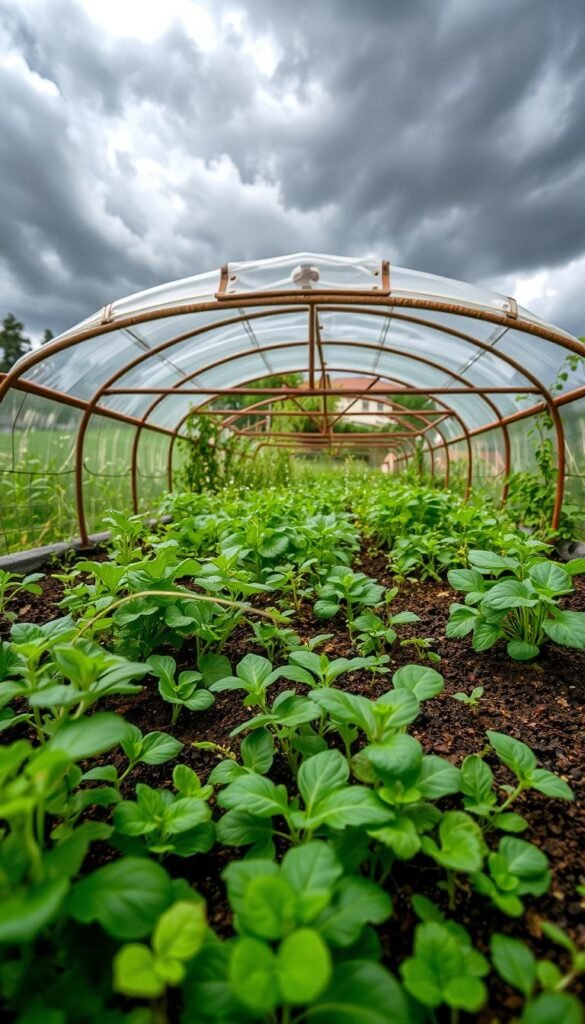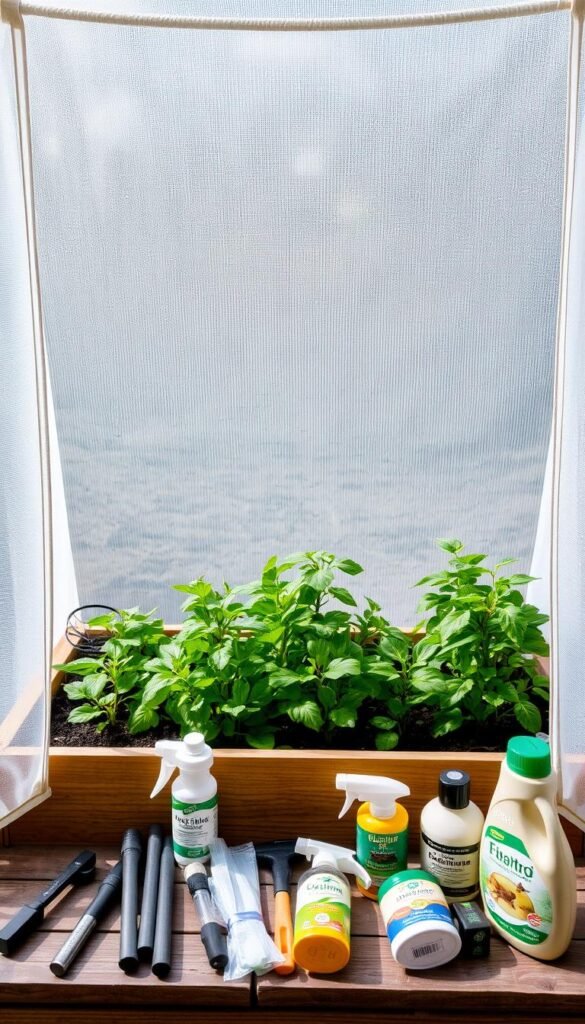Nothing stings quite like watching your carefully nurtured vegetables vanish overnight. Whether it’s curious critters or sudden frosts, outdoor growing comes with challenges. That’s where specialized mesh fabrics step in – letting light and water through while keeping unwanted visitors out.
Starting early makes all the difference. Young sprouts attract pests like magnets, making immediate coverage crucial. These barriers work year-round, adapting to seasonal threats – from summer heatwaves to early snowfalls. Pair them with properly constructed raised beds for maximum protection.
Modern options go beyond basic tarps. Breathable materials prevent overheating while durable designs withstand heavy rains. Some even offer UV protection, extending their lifespan through multiple growing cycles. Discover innovative solutions that balance airflow with pest resistance.
Your harvest deserves this shield. With the right barrier, you’ll spend less time worrying about losses and more enjoying homegrown flavors. It’s not just about survival – it’s about helping your green investments thrive.
Understanding the Importance of Protective Garden Covers

Uninvited guests and harsh skies threaten your edible investments daily. Plants grown in elevated plots face unique risks compared to their wild counterparts – they’re exposed to hungry insects, sudden temperature swings, and diseases spread by wind or rain. Without safeguards, your green treasures become easy targets.
Why Raised Beds Demand Extra Care
Elevated soil warms faster in spring but dries out quicker during droughts. This creates ideal conditions for pests like aphids and cabbage moths. A well-secured barrier stops invaders while letting rainwater through. In windy areas, choose weighted materials or use stakes to prevent flapping.
Healthier Crops, Bigger Harvests
Shielded vegetation grows more consistently. You’ll notice fewer chewed leaves and sun-scorched fruits. Proper coverage also reduces fungal issues caused by heavy rains. Many growers report doubling their yields after installing these defenses.
Want to enjoy fresh produce longer? Pair your setup with methods for extending your growing season. The right protection transforms unpredictable plots into reliable food sources, season after season.
Key Features and Material Options for Your Covers

Selecting the right barrier transforms how your crops handle nature’s curveballs. Three main options dominate the market, each solving specific challenges while letting your plants breathe. Let’s break down what works best for different scenarios.
Mesh Fabrics, Shade Cloth, and Solid Sheeting Explained
Mesh fabrics come in hole sizes from pinprick to quarter-inch. Larger gaps deter rabbits without blocking rain, while tighter weaves stop aphids. Polyethylene versions last 5-7 years, resisting UV damage better than basic netting.
Knitted shade cloth beats woven types in durability. A 30% filter protects tomatoes from scorching sun, while 70% versions help lettuce thrive in heatwaves. Unlike plastic sheeting, it won’t trap humidity underneath.
Solid plastic panels block hailstorms and frost effectively. But they demand vents or daily removal to prevent overheating. Use them temporarily during cold snaps rather than full-season coverage.
Pros and Cons of Different Materials
| Material | Best For | Airflow | Maintenance |
|---|---|---|---|
| Polyethylene Mesh | Insect control | Excellent | Low |
| 50% Shade Cloth | Heat reduction | Good | Moderate |
| Plastic Sheeting | Frost protection | Poor | High |
Ground-level pests? Fine mesh with buried edges stops burrowers. For windy areas, reinforced edges prevent tearing. Remember: heavier materials need sturdier frames. Match your choice to local weather patterns for the best way to safeguard your harvests.
Garden Covers for Raised Beds: Protecting Plants from Harsh Elements

Your green friends need Goldilocks conditions – not too hot, not too cold. Weather swings from baking heat to icy chills test their limits daily. The right shields act like a thermostat for your crops, balancing nature’s extremes.
Heat Waves Meet Their Match
When thermometers spike, shade cloth becomes your secret weapon. This breathable fabric cuts sunlight intensity by 30-70%, preventing leaf scorch on tomatoes and peppers. Unlike solid tarps, it lets hot air escape while keeping soil moisture stable.
Frost’s Worst Nightmare
Clear polyethylene sheets trap warmth like a greenhouse when cold snaps hit. They create a 5-10°F temperature boost around seedlings – often the difference between survival and frostbite damage. Remove them on sunny days to prevent overheating.
Storm Season Solutions
Heavy downpours? Reinforced netting breaks hail’s impact while letting 90% of rain through. For wind protection, choose tightly woven fabrics with grommeted edges. Pair them with sturdy frames that won’t collapse under pressure.
Pro tip: Rotate covers seasonally. Use shade cloth until autumn’s first frost warning, then switch to insulating plastic. This dual approach keeps beds productive through spring’s last freeze and summer’s worst heat dome.
DIY Options and Customization Techniques

Building your own protective barrier combines practicality with personalization. With basic tools and a weekend afternoon, you’ll create a tailored solution that fits your space perfectly. Let’s explore how to craft a durable shield that adapts to your needs.
Step-by-Step Build Plans for a Custom Cover
Start by measuring your raised garden bed – most standard designs use 3’x6′ dimensions. Cut eight 2×2 boards into four 6-foot lengths and four 3-foot pieces for the frame. Connect them using exterior screws at each corner, reinforcing joints with diagonal braces.
Attach chicken wire to the wooden frame using stainless steel staples, leaving a 2-inch overhang. Install brass hinges on one long side for easy access. Finish with a barrel bolt latch to keep winds from lifting your creation.
Essential Tools and Materials for Your Project
Gather these items before starting:
| Item | Purpose | Notes |
|---|---|---|
| Exterior-grade 2x2s | Frame construction | Resists rot and warping |
| 3′ wide chicken wire | Pest barrier | 30′ roll covers 10 linear feet |
| Miter saw | Precision cuts | 45° angles for braces |
| Stapler | Mesh attachment | Use 1/4″ stainless staples |
Customize your garden bed cover with removable panels for seasonal changes. Add irrigation ports or plant support slots during assembly. These tweaks save time during daily maintenance while keeping your greens protected year-round.
Remember: Proper measurements prevent material waste. Double-check each piece before cutting, and you’ll have a sturdy diy raised bed shield that lasts 5+ seasons. Total project time? About 4 hours for first-timers.
Designing Robust Frames and Structures
Your frame acts as the backbone of your plant protection system. Choosing the right materials ensures your setup withstands storms, supports your covers, and lasts through multiple growing seasons. Let’s explore three popular options that balance strength and practicality.
Wood vs PVC vs Metal: Material Showdown
Wooden frames offer classic durability with natural rigidity. They handle hinges and custom modifications easily but require yearly sealing to prevent rot. Perfect for permanent installations where weight isn’t an issue.
PVC pipes shine in temporary setups. Their lightweight design lets you move or store covers quickly. Use sandbags or ground stakes to anchor them during windy days – their main weakness.
Metal options like aluminum provide unbeatable longevity. While heavier and pricier, they won’t warp or attract pests. Ideal for extreme climates where other materials might fail.
| Material | Best Use | Durability | Weight |
|---|---|---|---|
| Wood | Permanent structures | 5-8 years | Heavy |
| PVC | Seasonal setups | 2-3 years | Light |
| Metal | Harsh weather areas | 10+ years | Medium-heavy |
Installation Secrets for Lasting Stability
Make sure your frame matches your bed’s exact measurements. Use these pro tips:
- Reinforce corners with triangular brackets
- Space support beams every 18-24 inches
- Attach covers using rust-proof clamps
For raised beds with uneven terrain, add adjustable legs. This prevents wobbling and keeps your structure level. Check attachment points monthly – tight connections prevent wind damage and maintain proper cover alignment.
Pest and Weather Protection Strategies

Your crops face sneaky threats from both above and below ground. Feathery visitors peck at tender shoots while tiny invaders chew through roots. A smart defense plan stops these uninvited guests without suffocating your plants.
Animal Deterrence Through Smart Barriers
Birds and squirrels hate tight-knit mesh. Use ½-inch holes to block their access while letting pollinators through. For burrowing creatures like voles, bury netting 6 inches deep around beds. This creates an underground fence they can’t dig past.
Deer require heavy-duty solutions. Pair 7-foot tall metal fencing with motion-activated sprinklers. This combo stops jumpers and deters persistent nibblers. Remember: Check local regulations before installing permanent barriers.
Weatherproofing Your Defense System
High winds test every structure. Secure netting with bungee cords instead of ropes – they flex without snapping. During storms, add diagonal supports to frames. This prevents collapse under heavy rain or hail.
Temperature swings demand adaptability. Use removable mesh panels during frost warnings. Swap them for shade cloth when heatwaves strike. This keeps roots cool while maintaining airflow.
| Threat | Solution | Key Feature |
|---|---|---|
| Small insects | Ultra-fine mesh | 0.2mm holes |
| Rabbits | Chicken wire | 1″ openings |
| Heavy rain | Reinforced PVC | Drainage vents |
Always anchor covers at soil level. Gaps let pests slip through like ninjas. A tight seal protects your harvest while letting plants breathe. Rotate defenses as seasons change for year-round security.
Installation and Maintenance Best Practices
Securing your plant shield correctly ensures it works when it matters most. A stable setup prevents gaps that let pests sneak in or harsh weather damage your crops. Let’s walk through simple ways to keep your defense system reliable season after season.
Locking Down Your Defense
Start by checking if your base structure is level and sturdy. Misaligned frames create weak spots. Place the bed cover evenly, ensuring corners match perfectly. If you need frequent access, use barrel bolts instead of screws – they let you detach the raised bed cover quickly without tools.
Keeping Protections Strong
Test hinges monthly and tighten loose fittings. Remove debris from mesh pores using a soft brush. Before transplanting seedlings outdoors, inspect covers for tears or weak spots. Store fabric types indoors during winter to prevent UV degradation.
Simple habits save time and money. A well-maintained garden bed cover lasts years, shielding your greens through every storm and heatwave. Your future harvests will thank you.






